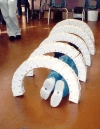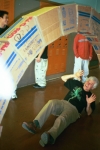
| Ertha Diggs and the Ancient Stone Arch Mystery |
|---|
Geometry teacher and author of
Discovering Geometry™: An Investigative Approach
THE SETTING
A geometry class in which students work
in cooperative groups of four to discover the properties of geometry.
They are familiar with the basic tools of geometry: compass and
straightedge, patty papers, and The Geometer's Sketchpad. They
have recently discovered the Interior Angle Sum Conjecture, the
Exterior Angle Sum Conjecture, and properties of trapezoids.
THE LESSON (DAY ONE).
I began the lesson by sharing photos and
transparencies of Roman and Chinese arches while discussing their
history and development. Whether true or not, my students especially
enjoyed the tale about the Roman architect for an arch. (According
to legend when the Romans made an arch, they would make the architect
stand under it while the wooden support was removed. That was
one way to be sure that architects carefully designed arches
that wouldn't fall!) During class discussion we arrived at the
geometric characteristics of an arch. We agreed that the arch
is half of a regular polygon. We conjectured that half the number
of sides of the regular polygon must be an odd number (in order
to have a keystone). For example half of a regular 18-gon gives
us an arch with 9 stones, 8 voussoirs and a keystone. Then each
group of four students was to design and build a two-dimensional
arch of isosceles trapezoids. I required the angle measures of
the isosceles trapezoids to be positive integers. The students
then discussed, planned, designed, and constructed their two-dimensional
arches. Next they wrote a description of what they did, describing
the mathematics used. But that was just the warm-up. As the period
came to a close I pulled out a box of Chinese take-out cartons.
I told them, in mock scientific seriousness, that "these
are stone voussoirs from an ancient miniature bridge uncovered
by my friend, archaeologist Ertha Diggs. She has asked us to
determine the number of stones in the original bridge."
I gave one to each group, the bell rang and class was dismissed.
THE LESSON (DAY TWO)
The lesson (day two). When the students
came in to class the next day they began discussing the problem
posed yesterday in their groups. I interrupted the group discussions
to announce that when a group determines how many pieces in the
original (Chinese take-out carton) bridge they are to write up
an explanation and then call me over. When they call me over
and explain their reasoning, I then give them the additional
cartons they think they need to build a replica of the bridge.
By the end of the period, when each group has built their arch,
we bring them all together and assemble them into a vault! Of
course these teenagers cannot resist crawling through the vault.
The objective was for students to review and apply the properties
of isosceles triangles, trapezoids, regular polygons, and of
interior and exterior angle sums. They were to practice communicating
mathematically and modeling in two and three dimensions. It is
a fun two-day activity of hands-on mathematics and problem solving.
TWO DAYS OF FOLLOW-UP NEAR THE END OF THE
SCHOOL YEAR.
Two
days of follow up near the end of the school year. During the
previous summer there was a lot of remodeling at our school site.
So we had a large number of used cardboard boxes folded flat
and stacked in piles all over the school building. Like most
teachers, when I see a free resource lying around I am compelled
to make use of it in some way. So I created a lesson on nets
for solids. I asked my students to explore all the possible non-congruent
nets for a particular isosceles trapezoidal prism. When completed
we selected the one to best fit on one of the folded flat cardboard
boxes. Once we had the largest possible net designed on the cardboard
we passed it around and each group traced it onto their cardboard.
That was day one. The next day they cut and assembled each net
into the isosceles trapezoidal stone ready for assembly into
an arch. Would the arch be large enough for us to walk under?
Having recently completed the trigonometry chapter I was determined
to get them to apply their new trig skills. The task of each
group was to measure their trapezoidal stone and calculate the
span and rise of the arch that was going to be created by these
voussoirs. By the second and third geometry classes of the day
we had enough voussoirs to complete the arch. It was agreed that
I was the chief architect of the arch so I was required to remain
beneath the arch as all supporting hands were removed. I managed
to survive the last stage of construction. Once again Geometry
and Architecture blended beautifully into a few days of fun applications
for my geometry students and myself.
 |
 |
 |
 |
 |
 |
ABOUT THE AUTHOR
Since
1990, with the publication of the first edition of Discovering
Geometry: An Investigative Approach (DG) (San Francisco: Key Curriculum Press, 1990) Michael Serra has continued to teach at George
Washington High School in San Francisco. When he is not teaching,
he is either writing new material or traveling all over the country
giving workshops to districts that have already adopted or
are thinking of adopting DG. He also gives presentations
at four or five National Council of Teachers of Mathematics (NCTM)
regional conferences, or state mathematics conference around
the country. In 2002 the third edition, Discovering Geometry:
An Investigative Approach was released. Other publications
include the very popular supplementary geometry book, Patty
Paper Geometry, and the set of five workbooks used as classroom
starters called Mathercise (Mathercise A-E). Key
Curriculum Press has just published his latest, What's Wrong
With This Picture? - Critical Thinking
Exercises in Geometry. His next project is a Patty Paper
Algebra book.
To order Discovering
Geometry: An Investigative Approach from Amazon.com, click
here.
|
Michael Serra, "Ertha Diggs and the Ancient Stone Arch Mystery", Nexus Network Journal, vol. 4, no. 4 (Autumn 2002), http://www.nexusjournal.com/Didactics-Serra-v4n4.html |
Copyright ©2002 Kim Williams Books

